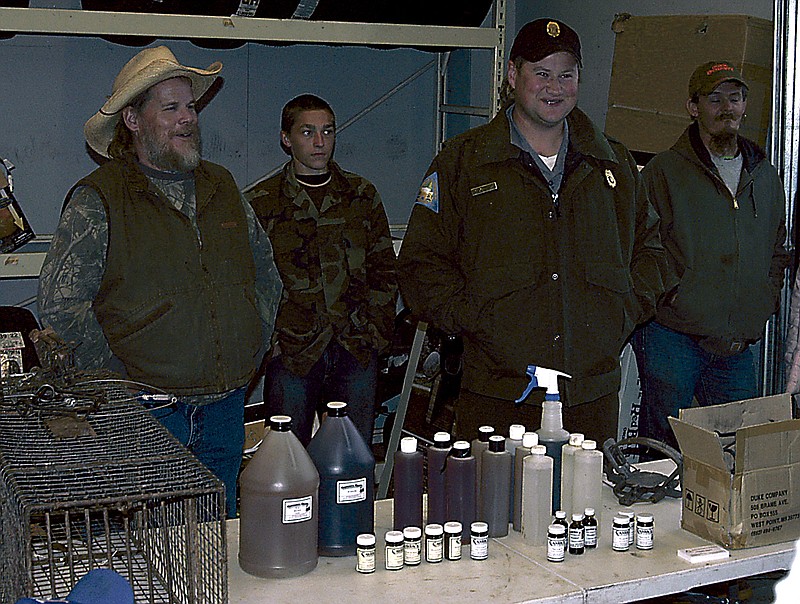Orscheln Farm and Home, California, hosted a clinic put on by Dale Vert of the Missouri Trappers Association (MTA), partially because trapping season starts Nov. 15. Conservation Agent Nathan Hodges also spoke at the event, held Saturday, Oct. 5. About two dozen people of varying skills checked out the equipment, lures and bait and learned how trapping is done, what is needed to do trapping and what is legal. Trap setting was demonstrated for different species.
The first part of the activities were restricted to an indoor area by a hard rain. The time was used by Vert to explain the legal requirements, such as the need for a trapping permit and which type of trapping needs special training and permits. "You need to know the law," he said. "Have a good relationship with your Conservation Agent."
One of the problems encountered is when fur prices are good, trapping draws people who don't know what the laws are, how much work it is to do it right, how often they have to run the traps for humane trapping or how to prepare the fur. Missouri Trappers Association publications are available to help with this.
Among other reasons, the publications are to help preserve the heritage of trapping furbearing animals, assist people in learning about trapping, "and to impress upon them the necessity of good sportsmanship and conservation of our natural resources". Since there is no legal hunting seaon for otter, beaver, mink and muskrat, legal trapping is the only way to take them, no matter how destructive they may be to the environment. Since being restored by the Missouri Department of Conservation, otters are overpopulated in some areas. Beavers are the most destructive of all furbearers, flooding farm land, blocking culverts, cutting down trees and field corn in bottom land fields.
Among the advice given by Vert and Hodges: running someone else's traps is unethical and illegal; and while landowners can trap on their own land without a seal (permit), the trapper's name has to actually be on the deed of the property.
Vert demonstrated the workings of various types of traps, preparation of the traps for use, where to set them for various animals, how often to check them and other necessary information.
Although most trapping is done for hides, apparently many of them for foreign buyers, Hodges said he favors trapping because it is useful for "handling a lot of nuisance stuff."
Trapping is considered important for ridding a neighborhood, or a farm area, of unwanted or excess animals. For example, a trapper might be called on to trap skunks which might have been raising a family in a residential neighborhood, living under porches, eating cat food and risking the spread of disease to domestic animals.
Last year, a farmer who had a problem with destruction caused by raccoons around his animal feed storage area called a trapper. In less than an acre of land, 46 raccoons were trapped in a few days.
New traps should be cleaned and stripped of paint, then coated and treated to get rid of the chemical smells and colored to blend in with the background. Although it is legal to trap on highway right-of-way, Vert recommends against it. "Get along with the landowners," Vert said. "You never have too much land available for trapping and deer hunting."
Vert explained some of the differences in trapping different species. "A coyote can smell rust on a trap and will dig it out," Vert said. "He won't be back for a week."
On the other hand, possums or bobcats can be caught in the same traps over and over. Bobcats may even play with the trap.
Vert explained that when trapping animals for their hides, it should be done in season for a good hide. There are specific ways to remove the animals skins, called a "money cut," and preferred ways to prepare the hides for sale. He also explained that anyone selling an animal skin should make sure its from an animal they have caught, since there are legal requirements on this basis. Otter and bobcat hides need to be tagged. Although both are apparently abundant, to the point of being a nuisance in some areas, records are needed.
Trapping has changed. The old wood box trap for rabbits used by many young people years ago has been replaced in the trapping world by a variety of other traps.
Although cage traps, used to catch skunks and other unwanted animals are still used, there are a many other kinds of traps. Vert demonstrated the use of several types of traps, including how to set them to do the job in a humane fashion.
Just as with anything else, people planning to trap for fur or to get rid of nuisance animals need to learn the laws regarding the activity and learn how to do it in an efficient and humane manner.

